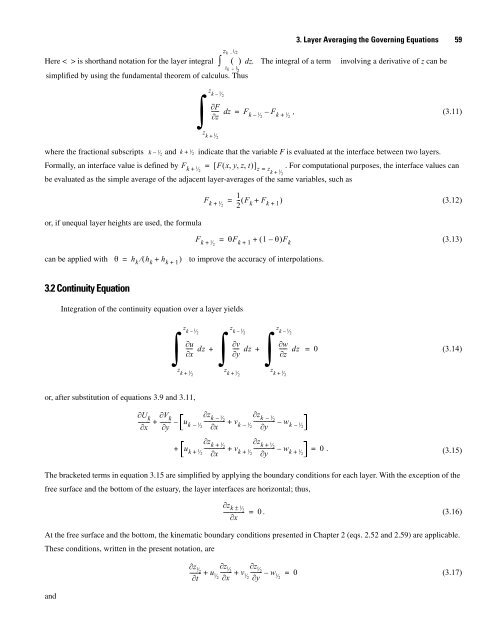A Semi-Implicit, Three-Dimensional Model for Estuarine ... - USGS
A Semi-Implicit, Three-Dimensional Model for Estuarine ... - USGS
A Semi-Implicit, Three-Dimensional Model for Estuarine ... - USGS
Create successful ePaper yourself
Turn your PDF publications into a flip-book with our unique Google optimized e-Paper software.
3. Layer Averaging the Governing Equations 59<br />
zk -<br />
Here < > is shorthand notation <strong>for</strong> the layer integral ∫<br />
1 /2<br />
( ) dz.<br />
zk + 1 /2<br />
simplified by using the fundamental theorem of calculus. Thus<br />
The integral of a term involving a derivative of z can be<br />
where the fractional subscripts k – 1⁄ 2 and k 1⁄ 2<br />
z<br />
k – 1⁄ 2<br />
∫ F<br />
z<br />
k + 1⁄ 2<br />
-----<br />
∂F<br />
dz<br />
=<br />
∂z<br />
k – 1⁄ – F<br />
2 k + 1⁄ , (3.11)<br />
2<br />
+ indicate that the variable F is evaluated at the interface between two layers.<br />
Formally, an interface value is defined by Fk + 1⁄ = [ Fxyzt ( , , , ) ]<br />
2<br />
z = zk . For computational purposes, the interface values can<br />
+ 1⁄ 2<br />
be evaluated as the simple average of the adjacent layer-averages of the same variables, such as<br />
or, if unequal layer heights are used, the <strong>for</strong>mula<br />
Fk + 1⁄ 2<br />
Fk 1⁄ 2<br />
can be applied with θ = hk ⁄ ( hk + hk + 1)<br />
to improve the accuracy of interpolations.<br />
3.2 Continuity Equation<br />
Integration of the continuity equation over a layer yields<br />
z<br />
k – 1⁄ 2<br />
∫z<br />
k + 1⁄ 2<br />
or, after substitution of equations 3.9 and 3.11,<br />
∂Uk<br />
∂Vk<br />
-------- + –<br />
∂x<br />
∂y<br />
1<br />
= -- ( F<br />
2 k + Fk + 1)<br />
(3.12)<br />
+ = θFk + 1 + ( 1 – θ)Fk<br />
(3.13)<br />
z<br />
k – 1⁄ 2<br />
∫z<br />
k + 1⁄ 2<br />
z<br />
k – 1⁄ 2<br />
∫z<br />
k + 1⁄ 2<br />
∂u<br />
∂v<br />
∂w<br />
----- dz + ---- dz + ------ dz = 0<br />
(3.14)<br />
∂x<br />
∂y<br />
∂z<br />
∂zk<br />
– 1⁄ ∂z<br />
2<br />
k – 1⁄ 2<br />
-------- uk – 1 ---------------<br />
⁄ + v<br />
2<br />
k – 1 ---------------<br />
⁄ – w<br />
2<br />
k – 1⁄ 2<br />
∂x<br />
∂y<br />
∂zk<br />
+ 1⁄ ∂z<br />
2<br />
k + 1⁄ 2<br />
uk + 1 ---------------<br />
⁄ + v<br />
2<br />
k + 1 ---------------<br />
⁄ – w<br />
2<br />
k + 1⁄ 2<br />
+ = 0 .<br />
∂x<br />
∂y<br />
(3.15)<br />
The bracketed terms in equation 3.15 are simplified by applying the boundary conditions <strong>for</strong> each layer. With the exception of the<br />
free surface and the bottom of the estuary, the layer interfaces are horizontal; thus,<br />
∂zk<br />
± 1⁄ 2 --------------- = 0 . (3.16)<br />
∂x<br />
At the free surface and the bottom, the kinematic boundary conditions presented in Chapter 2 (eqs. 2.52 and 2.59) are applicable.<br />
These conditions, written in the present notation, are<br />
and<br />
∂z1<br />
∂z1<br />
⁄ 2 ⁄ ∂z1<br />
2<br />
-------- u1 -------- ⁄ 2<br />
+<br />
∂t<br />
⁄ + v1 --------<br />
2 ∂x<br />
⁄ – w1 2 ∂y<br />
⁄ = 0<br />
(3.17)<br />
2

















